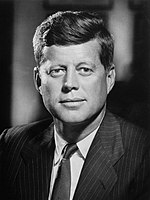
The 1956 United States presidential election was the 43rd quadrennial presidential election. It was held on Tuesday, November 6, 1956. Incumbent Republican President Dwight D. Eisenhower and his running mate, incumbent Vice President Richard Nixon, were re-elected, defeating for a second time Democrat Adlai Stevenson II, former Illinois governor. This election was the sixth and most recent rematch in American presidential history. It was the second time in which the winner was the same both times, the first being William McKinley's victories over William Jennings Bryan in 1896 and 1900. This was the last election before term limits established by the Twenty-second Amendment to the United States Constitution, which first applied to Eisenhower, became effective.
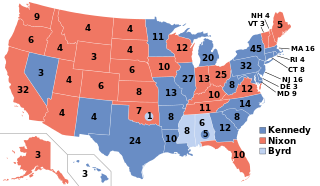
The 1960 United States presidential election was the 44th quadrennial presidential election, held on Tuesday, November 8, 1960. The Democratic ticket of Senator John F. Kennedy and his running mate, Senate Majority Leader Lyndon B. Johnson, narrowly defeated the Republican ticket of incumbent Vice President Richard Nixon and his running mate, U.N. Ambassador Henry Cabot Lodge Jr. This was the first election in which 50 states participated, marking the first participation of Alaska and Hawaii, and the last in which the District of Columbia did not. This made it the only presidential election where the threshold for victory was 269 electoral votes. It was also the first election in which an incumbent president—in this case, Dwight D. Eisenhower—was ineligible to run for a third term because of the term limits established by the 22nd Amendment.

The 1968 United States presidential election in North Carolina took place on November 5, 1968, and was part of the 1968 United States presidential election. Voters chose 13 representatives, or electors to the Electoral College, who voted for president and vice president. Whereas in the Deep South, Black Belt whites had deserted the national Democratic Party in 1948, in North Carolina, where they had historically been an economically liberalizing influence on the state Democratic Party, the white landowners of the Black Belt had stayed exceedingly loyal to the party until after the Voting Rights Act. This allowed North Carolina to be, along with Arkansas, the only state to vote for Democrats in all four presidential elections between 1952 and 1964. Indeed, the state had not voted Republican since anti-Catholic fervor lead it to support Herbert Hoover over Al Smith in 1928; and other than that the state had not voted Republican once in the century since the Reconstruction era election of 1872. Nonetheless, in 1964 Republican Barry Goldwater may have won a small majority of white voters, although he was beaten by virtually universal support for incumbent President Lyndon Johnson by a black vote estimated at 175 thousand.

The 1960 United States presidential election in Virginia took place on November 8, 1960. Voters chose 12 representatives, or electors to the Electoral College, who voted for president and vice president.
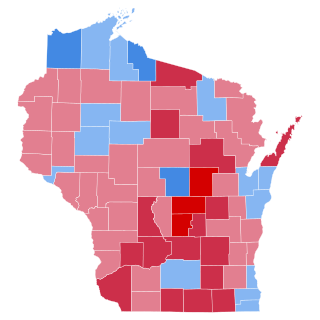
The 1960 United States presidential election in Wisconsin was held on November 8, 1960 as part of the 1960 United States presidential election. State voters chose 12 electors to the Electoral College, who voted for president and vice president. Politics in Wisconsin since the Populist movement had been dominated by the Republican Party. The Democratic Party became uncompetitive away from the Lake Michigan coast as the upper classes, along with the majority of workers who followed them, fled from William Jennings Bryan’s agrarian and free silver sympathies. Although the state did develop a strong Socialist Party to provide opposition to the GOP, Wisconsin developed the direct Republican primary in 1903 and this ultimately created competition between the “League” under Robert M. La Follette, and the conservative “Regular” faction. This ultimately would develop into the Wisconsin Progressive Party in the late 1930s, which was opposed to the conservative German Democrats and to the national Republican Party, and allied with Franklin D. Roosevelt at the federal level.

The 1952 United States presidential election in Mississippi took place on November 4, 1952, as part of the United States presidential election of 1952. The Democratic Party candidate, Governor Adlai Stevenson of Illinois, won the state of Mississippi over Dwight D. Eisenhower, the former Supreme Allied Commander Europe and General of the Army by a margin of 59,600 votes, or 20.88 percentage points. Eisenhower went on to win the election nationally, with 442 electoral votes and a commanding 10.9 percent lead over Stevenson in the popular vote.

The 1968 United States presidential election in Mississippi was held on November 5, 1968. Mississippi voters chose seven electors, or representatives to the Electoral College, who voted for President and Vice-President. During the 1960s, the Civil Rights Movement dictated Mississippi's politics, with effectively the entire white population vehemently opposed to federal policies of racial desegregation and black voting rights. In 1960, the state had been narrowly captured by a slate of unpledged Democratic electors, but in 1964 universal white opposition to the Civil Rights Act and negligible black voter registration meant that white Mississippians turned almost unanimously to Republican Barry Goldwater. Goldwater's support for "constitutional government and local self-rule" meant that the absence from the ballot of "states' rights" parties or unpledged electors was unimportant. The Arizona Senator was one of only six Republicans to vote against the Civil Rights Act, and so the small electorate of Mississippi supported him almost unanimously.
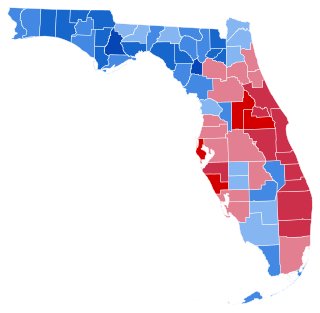
The 1952 United States presidential election in Florida took place on November 4, 1952, as part of the 1952 United States presidential election. Florida voters chose ten representatives, or electors, to the Electoral College, who voted for president and vice president.

The 1964 United States presidential election in South Carolina took place on November 3, 1964, as part of the 1964 United States presidential election. South Carolina voters chose 8 representatives, or electors, to the Electoral College, who voted for president and vice president.

The 1960 United States presidential election in Tennessee took place on November 8, 1960, as part of the 1960 United States presidential election. Tennessee voters chose 11 representatives, or electors, to the Electoral College, who voted for president and vice president.

The 1960 United States presidential election in South Carolina took place on November 8, 1960, as part of the 1960 United States presidential election. South Carolina voters chose eight representatives, or electors, to the Electoral College, who voted for president and vice president.

The 1956 United States presidential election in North Carolina took place on November 6, 1956, as part of the 1956 United States presidential election. North Carolina voters chose 14 representatives, or electors, to the Electoral College, who voted for president and vice president.

The 1956 United States presidential election in South Carolina took place on November 6, 1956, as part of the 1956 United States presidential election. South Carolina voters chose eight representatives, or electors, to the Electoral College, who voted for president and vice president.

The 1956 United States presidential election in Alabama took place on November 6, 1956, as part of the 1956 United States presidential election. Alabama voters chose eleven representatives, or electors, to the Electoral College, who voted for president and vice president. In Alabama, voters voted for electors individually instead of as a slate, as in the other states.

The 1956 United States presidential election in Tennessee took place on November 6, 1956, as part of the 1956 United States presidential election. Tennessee voters chose eleven representatives, or electors, to the Electoral College, who voted for president and vice president. Incumbent Republican Dwight D. Eisenhower narrowly carried the state over Democratic candidate Adlai Stevenson, becoming the first Republican nominee ever to carry the state more than once.

The 1952 United States presidential election in Alabama took place on November 4, 1952, as part of the 1952 United States presidential election. Alabama voters chose eleven representatives, or electors, to the Electoral College, who voted for president and vice president. In Alabama, voters voted for electors individually instead of as a slate, as in the other states.
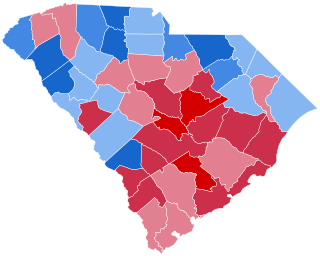
The 1952 United States presidential election in South Carolina took place on November 4, 1952, as part of the 1952 United States presidential election. South Carolina voters chose 8 representatives, or electors, to the Electoral College, who voted for president and vice president.

The 1952 United States presidential election in North Carolina took place on November 4, 1952, as part of the 1952 United States presidential election. North Carolina voters chose 14 representatives, or electors, to the Electoral College, who voted for president and vice president.

The 1948 United States presidential election in South Carolina took place on November 2, 1948, as part of the 1948 United States presidential election. State voters chose eight electors to the Electoral College, which selected the president and vice president.

The 1952 United States presidential election in Tennessee took place on November 4, 1952, as part of the 1952 United States presidential election. Tennessee voters chose 11 representatives, or electors, to the Electoral College, who voted for president and vice president.

